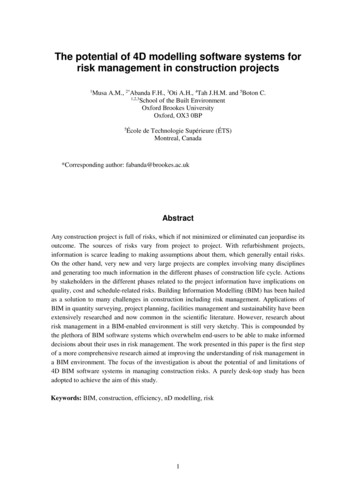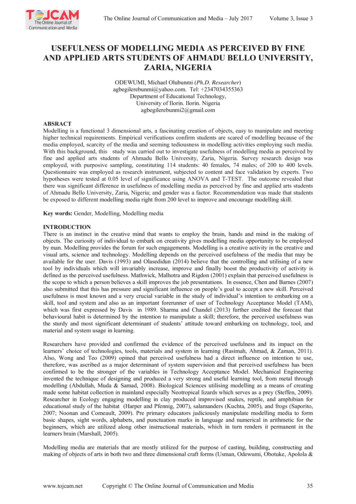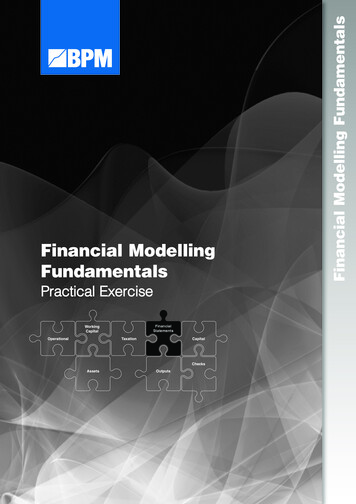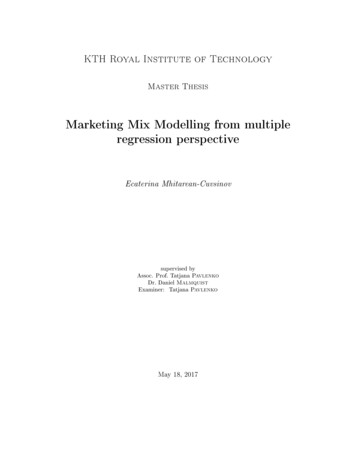
Transcription
The potential of 4D modelling software systems forrisk management in construction projects1Musa A.M., 2*Abanda F.H., 3Oti A.H., 4Tah J.H.M. and 5Boton C.1,2,3School of the Built EnvironmentOxford Brookes UniversityOxford, OX3 0BP5École de Technologie Supérieure (ÉTS)Montreal, Canada*Corresponding author: fabanda@brookes.ac.ukAbstractAny construction project is full of risks, which if not minimized or eliminated can jeopardise itsoutcome. The sources of risks vary from project to project. With refurbishment projects,information is scarce leading to making assumptions about them, which generally entail risks.On the other hand, very new and very large projects are complex involving many disciplinesand generating too much information in the different phases of construction life cycle. Actionsby stakeholders in the different phases related to the project information have implications onquality, cost and schedule-related risks. Building Information Modelling (BIM) has been hailedas a solution to many challenges in construction including risk management. Applications ofBIM in quantity surveying, project planning, facilities management and sustainability have beenextensively researched and now common in the scientific literature. However, research aboutrisk management in a BIM-enabled environment is still very sketchy. This is compounded bythe plethora of BIM software systems which overwhelm end-users to be able to make informeddecisions about their uses in risk management. The work presented in this paper is the first stepof a more comprehensive research aimed at improving the understanding of risk management ina BIM environment. The focus of the investigation is about the potential of and limitations of4D BIM software systems in managing construction risks. A purely desk-top study has beenadopted to achieve the aim of this study.Keywords: BIM, construction, efficiency, nD modelling, risk1
1. IntroductionSimilar to most projects, construction projects are highly subjected to risks. This is furtherexacerbated by their complexities, dynamism and peculiar nature (Rostami et al., 2015;Taillandier et al., 2015). Rostami et al. (2015) argued that construction projects are subjected tomore risks and uncertainties because of the varying range of activities and transformationinvolved from the planning stage to completion. Such activities include complex planningprocedure, regularly bespoke and time-consuming design as well as costly production processes.Furthermore, construction projects are becoming increasingly larger and more complex inphysical size and cost. If not effectively managed, the risk associated to this huge size can leadto losses (Chen et al, 2012). Also, projects are based on teamwork with different interestedstakeholders, and the co-operation among them is formed around extensive, disparate andinterrelated processes. People are very unpredictable in behaviour, compounded byunpredictable external environmental risk factors in delivering projects can be very high.Construction projects involve a lot of decision-making with consequences on the project’ssuccess or failure (in terms of cost, time and quality) and on its environment (Taillandier et al.2015). Sawhney et al. (2014) argued that construction is confronted by challenges such as timeand cost overruns, wastage, low levels of standardisation, fragmentation, inconsistentprocurement practices and low use of technology. Studies by Abderisak and Lindahl (2015)revealed that cost and time overruns are quite common with increases in the range of 50-100%being more regular and an increase of over 100% is not an unusual case. The risk associatedwith cost and time overruns will have immense effects on the outcome of any project if notproperly managed.Digitization of construction using BIM offers innovative ways to effectively manageconstruction risks (Hartmann et al, 2012; Tomek and Petr, 2014). Mott MacDonald, amanagement, engineering and development consultancy, defines BIM as “a coordinated set ofprocesses, supported by technology that adds value through creating, managing and sharing theproperties of an asset throughout its lifecycle (Mott MacDonald, 2015).” In order to supportBIM workflow of processes, a market for BIM technologies has significantly grown in recentyears. Although the growth of BIM software is great, its huge number and other technical issueshave posed challenges for end-users. Lee and Sexton (2007) argued that there is a lack ofholistic information for relevant construction parties regarding the characteristics of the varioussoftware packages and their appropriate uses. Furthermore, issues of non-compatibility(interoperability) among software packages are still too common. Day (2011) argued thatdepending on the software put to use, BIM models get very large in file size as the level ofdetail increases and this poses problems to computers with limited memory sizes. Fazli et al(2014) claimed that one of the major weaknesses is getting different file formats to functionproperly when creating a combined building information model. When data is taken from theoriginal BIM model, a certain value is attained and when converted into another file format, adifferent value can be generated. A recent study by Abanda et al. (2015) led to the identificationof/and differences between 122 BIM software systems across different construction domains.However, the study was top level with lack of details on specific domains. Building on Abandaet al. (2015), this study aims to conduct a detail investigation of BIM risk management software2
systems with focus on interoperability amongst the different software systems. Three mainobjectives employed to achieve the objectives of this study are: an Investigation into whyconstruction risk management is required; the identification of the various commonly usedscheduling and 4D BIM software for construction risk management; an investigation into theinteroperability amongst the scheduling and 4D BIM software systems.To facilitate understanding, the remainder of this paper is divided into 4 sections. In section 2,the methods used to achieve the aim of this study are examined. To provide the context of thisstudy, in section 3, risk management in construction is explored. This is followed by anassessment of the traditional scheduling and 4D BIM software systems, where emphases wasplaced on the type of operating systems supporting the software, the import/export file formatsof the software and whether risk has been integrated into the software. In section 4, the keyfindings and how the study objectives have been achieved are discussed. The paper concludesby a way of summary in section 5.2. Research methodsGiven that the core of this study is based on interoperability, its definition is important toprovide a context for the adopted research method. Generally four types of interoperability existin the literature. These are syntactic, technical, semantic and organisation interoperability(Rezaei et al., 2014). For purposes of this study, the focus is on syntactic interoperability whichrefers to the ability of two (or more) separate systems or software programmes to communicateand exchange data (or information) with each other and use the data (or information) that hasbeen exchanged (Rezaei et al., 2014; Bahar et al., 2013). With this definition in mind, fourcriteria for the different software to be reviewed were established. The first criterion considerswhether the software can be installed on two most popular operating systems, i.e. Mac andWindows. The second was based on how legacy scheduling/risk management tools wereintegrated into 4D BIM tools. By integration we mean the ease with which 4D BIM can readinto legacy scheduling and/or risk management tools. The third criterion is about the fileexchange formats inbuilt into the software system. The last criterion is about whether risk isintegrated as part of the scheduling or 4D BIM software systems. These criteria are captured inthe framework shown by Figure 1.3
Figure 1: Factors qualifying the potential of construction scheduling softwareBased on Figure 1, an extensive literature review from peer-reviewed sources and vendors’websites was conducted. Giving the emerging nature of BIM, peer-reviewed studies about BIMsoftware are scarce and the few existing studies have tapped information from vendors’websites (e.g. Crawley et al. (2008) and Abanda et al. (2015)). In examining the vendors’websites, the specification documents were explored to identify the different operating systems,file exchange formats supported by the different software systems, whether scheduling and/orrisk software was integrated in 4D BIM software systems and finally, whether risk has beenintegrated in the software. To further gain clarity about the set criteria for this investigation,some of the software were installed and explored. That led to the identification and inclusion of34 project scheduling, 3 legacy risk management software and 20 4D BIM software systems.3. Risk management and its digitization in constructionRisk management involves creating uncertainty awareness, qualifying the risks, managing thecontrollable risks and curtailing uncontrollable risks impact by risk allocation/appointment (Liuet al, 2007). There are many definitions of risk management, all portraying the fundamentalgoal of minimizing the impact of risk. According to Irimia-Dieguez et al. (2014), riskmanagement is the systematic process of identifying, analysing and responding to project risk.Also, Tohidi (2011) defined risk management as the process of identifying and assessing risk,and applying methods to reduce it to an acceptable extent. Hence, risk management involves theprocess of determining the likelihood of risk to occur, taking necessary steps to examine itseffects and fashioning out ways to prevent or lessen the effects, in the event that it occurs.Generally, managing projects revolves around the proper management of the delivery of projectobjectives in terms of time (scheduling), cost, quality and safety as most risks emanate fromthem. The focus of this study is on risk associated with construction project scheduling. Inemerging BIM paradigm, 4D stands for scheduling in a BIM tool. As such the discussionensuing in this section concerns the applications of risk management in traditionalsoftware systems and contemporary risk management approaches in BIM enabledenvironments.4
3.1 Risk management in traditional scheduling softwareProject scheduling is important for construction project managers as it facilitates their task oftracking and managing the triple constraints of time, cost and quality of projects (Faghihi et al.,2014). Planning and scheduling in construction normally involves activity sequencing in spaceand time, taking into account other construction processes like procurement, resources, spatialconstraints, etc. Traditionally, bar charts (Gantt charts) are used to schedule constructionactivities but these methods have been unable to show how or why certain activities are linkedin a given sequence (Eastman et al., 2011). Once these schedules are created, there appears to beno direct link between the computer-aided-design (CAD) drawings and the constructionschedule. As the design progresses in typical project scenarios, the construction managerreviews any updated drawings, then updates the schedule to reflect these design changes wheresuch clarification depends on the accuracy of the construction manager (Hardin, 2009). Eastmanet al. (2011) further argued that the spatial components aren’t adequately captured by thetraditional methods and nor are they linked to the building model. Further claims were thatscheduling (using the traditional methods) is manually intensive and often at times does notconcur with the design thereby creating complications for project stakeholders to understand theschedule and its impacts on site logistics. Two most common software systems used intraditional scheduling are MS Project and Primavera. It is important to note that traditionalsoftware has been in existence for ages even before the advent of BIM and/or 4D BIMmodelling. While some traditional scheduling software systems have compatible plug-ins with4D BIM, others do not. Also some have integrated BIM while others have not. A summary ofthe different project scheduling software uncovered are presented in Table 1.Table 1: An overview of construction scheduling software systemsSoftwareExport file formatImport file formatYesHTML, CSV, MPX,XML, XERPDB, MPX, XML,XER, DIR, STXYesWindows/MacConceptDrawPROJECTNoXML, MMAP CDPZ,CDPX, CDPTZ,CDMZ, TXT,CDPZ, CDPX, CDPTZ,CDMZ, TXT, MMAP,XML, MPP, MPT,MPX, XLSXNoWindows/MacDeltek OpenPlanNoXML, CSVXERYesWindows/MacExpressProjectNoExpress Project filesExpress Project files,CSVNoWindows/MacFast TrackScheduleNoHTML, MPX, XML,ICS, MMAPMPP, MPT, XML,MPXNoWindows/MacGantt ProjectNoCSV, MPX, XML,HTML, PDF, GAN,CSV, ICS, TXT, XML,GANNoWindows/MacMicroPlannerX-PertNoTXT, DIF, CSV, XMLTXT, DIF, CSV, iskanalysisintegrationOperatingsystem
MPP, MPX, XML,MPT, XLS, XLSX,XLSB, XLSM, CSV,TXTYes (2010and laterversions)Windows/MacMS ProjectYesXML, MPT, MPP,CSV, TXT, XLSMilestonesProfessionalNoXML, PDF, MPX, CSV,TXTXML, MPX, CSV, TXT,MPP, MPDNoWindows/MacOrganiserNoORG, HTMLORGNoWindows/MacPhoenixProjectManagerNoMPX, XML, XER, XLS,XLSX, SDEF, CSVMPX, XML, XER, XLS,XLSX, CSV, P3NoWindows/MacPMA NetpointYesXML, XERXMLYesWindows/MacPrimaveraYesXML, XLS, XERXER, XML, XLSYesWindows/MacProjectCommanderNoXLS, MPX, TXT, CSV,WMF, DOC, PPTMPX, TXT, CSV, XLSYesWindows/MacProjectKickStartNoPRX, MPXPRX, PRJ, MPX, CSVNoWindows/MacProjectLibreNoPOD, XMLMPP, MPX, XML,POD, PLANNERNoWindows/MacP2wareProjectManagerNoPDF, HTML, XLSX,CSV, TXT, RTF, MHT,MPP, XMLXLSX, PLAN, MPP,XML, MPXYesWindows/MacProject XpertNoMPX, XML, ICS, CSP,PRJCSP, MPP, MPX,XML, ICSNoWindows/MacRational PlanProfessionalNoSRP, XRP, XML, XLS,MRPSRP, MRP, XRP, MPP,XML, MPX, MPTNoWindows/MacRisky ProjectNoMPX, Decision TreeMPP, XMLYesWindows/MacSafranProjectNoSP, MPD, MPX, XML,XER, DBF, P3SP, SPP, ART, MPX,MPD, XML, XER, P3,PM, XMLYesWindows/MacSure TrackProjectManagementSoftwareYesMPX, P3, HTMLMPX, P3NoWindows/MacTurbo ProjectNoMPD, PEP, MPXMPD, PEP, MPXNoWindows/MacAltiprojectNoXLS, BusinessObjectsXLS, BusinessObjectsNoMacCurioNoICS, HTML, PDF,RTF, TXT, CSVRTF, ICSNoMacNoiTaskX (Project),iTaskX (Template),XML, MPX, OPML,TXT/CSV, MPP, ICSOPML, TXT/CSV, ICS,MPP, XML, MPX,TXT, CSVNoMaciTaskX6
iMindQNoXLS, XML, PDF,HTML, CSVXLS, XMLNoMacInvoax Plan itNoHTML, CSV, ICS, XMLXMLNoMacMerlinProjectNoXML, MPX, MMAP,NovaMind, TXT/CSV,HTML, OPML, XLSMPP, XML, MPX, XLS,MMAP, NovaMind,OmniOutlinerNoMacOmniPlanNoICS, CSV, MPX, XML,HTML, OmniOutliner,OmniGraffleXML, MPX, MPPNoMacProject XNoICSICSNoMacSG ProjectProNoPDF, XML, SGPXML, SGPYesMacX PlanNoXML, ICS, xView,XList5XMLNoMac@RISKNoXLS, DOC, PPT,MPX/MPP, XML, XLSYesWindows/MacCrystal BallNoXLS, CSV, TXT, DIF,PDF, XPS, XMLXLS, XML, TXT, DIF,dBaseYesWindowsRisk SolverNoXLS, PDF, TXT, XMLXLS, XMLYesWindows3.2 Risk management in 4D BIM software systemsSebastian (2011) argued that BIM is not the same as the widely known computer aided design(CAD) because it goes beyond generating the traditional digital (2D or 3D) drawings. It is anintegrated model in which all process and product information is combined, stored, elaboratedand interactively distributed to all relevant project actors. Also, the proposed design andengineering solutions can be assessed against the client’s requirements and expected buildingperformance using BIM. The use of BIM during the construction phase can support goodcommunication network between the building site, the factory and the design office (Sebastian,2011). Fazli et al. (2014) also argued that communication processes that exist betweenstakeholders in a project can be enhanced massively through BIM. This is in contrast totraditional projects in which building visualizations (views) are made from scratch while BIMbased projects, the visualizations can be made from previously created models and can bemonitored real-time. The schedule of construction is directly linked to the 3D model, enhancingvisualization of the sequential construction or sequence activities of the building, thus allowingschedulers to visually plan and communicate activities in the context of space and time(Eastman et al., 2011). Furthermore, Hartmann et al. (2012) discussed that project risks arecommunicated as a risk inventory using Gantt charts and sketches that however, do not allowproject managers to completely visualize and understand risks, their location on site and theirimplications on project deliverables making it hard to collaboratively examine and mitigateproject risks. The argument was that 4D models capture both the temporal and spatial aspects ofschedules and communicate schedules more effectively than Gantt charts. In the experimentalstudy carried out by Reizgevičius et al. (2013), they argued that 4D models can shorten7
construction time by 1/3. Furthermore, they claimed that the use of 4D CAD model can reducemistakes to a greater extent (twice as much) in construction processes and help in detecting andremoving them more quickly. In Hartmann et al. (2012), a case study showed that if timeschedule is aligned well with existing risk management processes, design teams can use 4Dmodels to visualize project risks in time and space. Mahalingam et al. (2010) discussed that 4DCAD are beneficial in the planning and construction stage where in the former, it will be usefulin communicating the construction plans and processes to clients who can then visualize theproject and convey their suggestions, approval or disapproval. In the construction stage, it willbe particularly useful in comparing the constructability of work methods visually in order todetect conflicts or clashes. It also serves as a visual tool for contractors, clients, subcontractorsand vendors to review and plan projects’ progress. The summary of the 4D BIM softwareuncovered in this study are presented in Table 2. Even if many 4D software deal implicitly withmany aspect of risk management (logistics, space, etc.), the risk analysis integration consideredhere is the explicit feature included in the software. It is important to note that some of thesoftware systems are also 5D BIM systems, i.e. 3D plus cost dimension.Table 2: An overview of 4D BIM software systemsSoftwareExport formatsImport formatsRiskanalysisOperatingAutodesk Navisworks3D DWF, DWFx, FBX,KML, NWD, NWFTXT, ASC, DGN, PRP, PRW, DWF,DWFx, W2D, DWG, DXF, FBX, IFC,RVT, SKP, NWD, NWF, NWCNoWindowsAVEVA NET PlayerXML, PDF, PPT, HTML,SVG, DOCHTML, XLS, XML, SVGNoBentley ConstructSimXLS, IFCISO, XLS, DGN, DWG, PDS, PDMS,IGES, IFCBentley NavigatorIFC, PDFIFC, DGN, DWG, DXF, SKP, PDF, IGES,KML,XML, XERDassault SystemesCATIA3D XML, DWG, DXF,PDF, IGS3D XML, DXF, CATProduct, IG2, IGSNoDassault SystemesCivil Design forFabricationIFCIFCNoDassault SystemesDelmiaIFCXML, XER, IFCNoWindows/UnixDassault SystemesOptimized PlanningIFCIFCNoWindowsDigital ProjectExtensionsIFC, XML, HTMLIFC, XER, XML, DWG, DXF, IGES, SDNFNoWindowsD-Studio 4D VirtualBuilder4D PPT, IFCXML, MPP, MDP, PP, IFCNoWindowsDESTINI Profiler(Beck Technologies)DWG, DXF, eQUEST,IFC, IGES, KML/KMZ,STL, XLSPDF, DWG, DXF, XLS, RVT, PEE, ndowsWindows
Innovaya 4D/5DSimulation andEstimatingINV, HTML, DOC,XML, INV, XER, XLS, RVT, MPX, DWGYesWindowsIntergraph SmartPlantConstructionXER, IFCXER, XML, IFC, DWG, DXF, DGN, PDS,PDMS, CAESAR II, SAT, XMpLant,CADWorxNoWindowsOnuma PlanningSystemGBXML, IFC, COBie,KML, BIMXML,CityGMLIFC, OGC, OSCRE, COBie, XLS, KML,CSV, GBXML, XML, BIMXML, CityGMLNoWindows/Mac/LinuxSolibri Model CheckerIFC, PDF, RTF, XLS,SMCIFC, DWG, DXF, DGN, SKP, SMCNoWindows/MacSynchro SoftwareSP, XML, XER, IFC,XLS, P3XML, P3, XER, IFC, SP, NP4YesWindowsTekla StructuresPDS, XML, PML, SCIA,HLI, DWG, DXF, DGN,IFC, SDNF, SKP, PDMSIFC, DWG, DXF, DGN, XML, HLI, SDNFNoVico VirtualConstructionXML, XLS, DOC, PDFIFC, SKP, DWG, sbXML, XLSx, XML,CAD-DUCTYesWindowsRIB iTWOIFC, XML, XER, MPX,RPA, RPDIFC, XML, XER, MPX, XLS, RPA, RPDNoWindows/MacVisual 5DAvi, mpegCinema 4d, Blender, 3ds max, .RVTNoWindowsWindows4. Findings and discussionTables 1 and 2 provide an overview of some scheduling and 4D BIM software systems and howthey integrate with BIM. The software systems were classified according to the different criteriaset in section 2. A summary of how the research objectives were achieved will be discussed.Table 3: How the research objectives were achievedTo investigate why construction risk management is required;This was achieved through a literature review and discussed in sections 1 and 3. In section 1, therationale for risk management in construction projects was examined. Then in section 3, the rationaleand benefits for digitising risk management were discussed.To identify the various commonly used scheduling and 4D BIM software for construction riskmanagement;This was achieved through an extensive literature review. Peer-reviewed and vendors’ websites served assource of information. The findings from this review were presented in Tables 1 and 2.To investigate the interoperability amongst the scheduling and 4D BIM software systems;Once the software systems were identified, the specification manuals were read to determine the softwarecharacteristics (e.g. file import and export format). Furthermore, in some cases some of the software hadto be installed and explored to determine whether it is compliant with BIM, types of file exchange formatsand whether it contains risk components.By achieving the objectives, four main findings were uncovered. Firstly, some traditionalconstruction scheduling software are BIM compliant and also contain a risk analysis9
component. For example, Asta PowerProject has a risk component, and its project can be readby 4D BIM software system (e.g. Synchro). Secondly, most traditional scheduling software arenot yet integrated in BIM and do not contain a component for analysing risk in construction(e.g. Project Xpert and Rational Plan Professional). Thirdly, some 4D BIM software systemshave a risk analysis component (e.g. Synchro and Vico) while others do not (e.g. Navisworks).The last is that some scheduling and 4D BIM software systems can be installed on Mac and/orWindows operating systems. The findings from this study can be modelled using a Venndiagramme (Figure 2) which reveals the relationship between the different software systems.Figure 2: Software category summary5. ConclusionsWith construction projects increasingly becoming larger and more complex, there is the need forefficiency in the way construction activities are carried out. The construction industry is knownfor its inefficiencies, and amongst many, scheduling (time) risk is not left out. This study hasexplored the domain of risk management through which an understanding of the variousproblems that give rise to risks in construction projects was achieved. Consequently, some ofthe available traditional scheduling software systems were examined based on their compliancewith BIM. However, it was clear that these software systems are not quite efficient inspecifically managing scheduling risk. With the global advancement in technology, BIM hasemerged as a technology capable of bringing more efficiency in the way the industry operates. Itis in this regard that a critical appraisal of 4D BIM software systems was carried out. Although,BIM is still in its early phases, one of the benefits of BIM is that it can further enhance betterrisk management through 4D modelling. Through 4D modelling, project managers can be ableto visualize the virtual construction of any project, identify any risk associated and make moresubjective decisions rather than objective decisions. The traditional software systems are notcapable of doing so but with 4D software systems, this is possible. This has been illustratedthrough the different literatures in this paper as well as the critical appraisal of some of the 4Dsoftware systems presented. Nonetheless, this study has not investigated how schedule risk10
management can be performed in a BIM environment. Future studies will focus on theprocesses of undertaking schedule risk management in a BIM environment for properunderstanding of how to manage risk using BIM.ReferencesAbanda F.H., Vidalakis C., Oti A.H. and Tah J.H.M. (2015) A critical analysis of BuildingInformation Modelling systems used in construction projects. Advances in EngineeringSoftware, 90: 183-201.Abderisak, A and Lindahl, G (2015), ‘Take a chance on me? Construction client’s perspectiveon risk management’, Procedia Economics and Finance, 21, 548-554.Bahar Y.N., Pere C. Landrieu J. and Nicolle C. (2013) A thermal simulation tool for buildingand its interoperability through the Building Information Modelling (BIM) platform. Buildings,3: 380-398.Chen, S, Griffis, F.H, Chen, P, Chang, L (2012), ‘Simulation and analytical techniques forconstruction resource planning and scheduling’, Automation in Construction, 21: 99-113.Crawley, D.B., Hand, J.W., Kummert, M. and Griffith, B.T. (2008). Contrasting the capabilitiesof building energy performance simulation programs. Building and Environment, 43: nu-35/450-the-trouble-with-bim [Accessed July 2015].Eastman, C, Teicholz, Paul, Sacks, R, Liston, K (2011), BIM Handbook: A guide to BuildingInformation Modelling for owners, managers, designers, engineers and contractors. 2nd edn.New Jersey: John Wiley and Sons, Inc.Faghihi, V, Reinschmidt, K. F, Kang, J.H (2014), ‘Construction scheduling using GeneticAlgorithm based on Building Information Model’, Expert Systems with Applications, 41(16):7565-7578.Fazli, A, Fathi, S, Enferadi, M.H, Fazli, M, Fathi, B (2014), ‘Appraising effectiveness ofBuilding Information Modelling (BIM) in project management’, Procedia Technology, 16:1116-1125.Hardin, B (2009), BIM and Construction Management: Proven tools, methods and workflows.1st edn. Indiana: Wiley Publishing Inc.Hartmann, T, van Meerveld, H, Vossebeld, N, Adriaanse, A (2012), ‘Aligning buildinginformation model tools and construction management methods’, Automation in Construction,22: 605-613.11
Irimia-Dieguez, A. I, Sanchez-Cazorla, A, Alfalla-Luque, R (2014), ‘Risk Management inMegaprojects’, Procedia-Social and Behavioural Sciences, 119: 407-416.Lee, A and Sexton, M.G (2007), ‘nD modelling; industry uptake considerations’, ConstructionInnovation, 7(3): 228-302.Liu, J, Li, B, Lin, B, Nguyen, V (2007), ‘Key issues and challenges of risk management andinsurance in China’s construction industry’, Industrial Management and Data Systems, 107(3):.382-396.Mahalingam, A, Kashyap, R, Mahajan, C (2010), ‘An evaluation of the applicability of 4DCAD on construction projects’, Automation in Construction, 19(2): /building-information-modelling-bim [Accessed July2015].Rezaei R., Chiew T.K., Lee S.P. and Aliee Z.S. (2014) Interoperability evaluation models: Asystematic review .Computers in Industry, 65(1): 1-23Reizgevičius, M, Ustinovičius, L, Rasiulis, R (2013), ‘Efficiency Evaluation of 4D CADModel’, Procedia Engineering, 57: 945-951.Rostami, A, Sommerville, J, Wong, I.L, Lee, C (2015), ‘Risk management implementation insmall and medium enterprises in the UK construction industry’, Engineering, Construction andArchitectural Management, 22(1): 91-107.Taillandier, F, Taillandier, P, Tepeli, E, Breysse, D, Mehdizadeh, R, Khartabil, F (2015), ‘Amulti-agent model to manage risks in construction project (SMACC)’, Automation inConstruction, 58: 1-18.Tohidi, H (2011), ‘The role of risk management in IT systems of organizations’, ProcediaComputer Science Journal, 3: 881-887.Tomek A. and Petr M. (2014), ‘The impact of BIM on risk management as an argument for itsimplementation in a construction company’, Procedia Engineering, 85: 501-509.Sawhney A, Agnihotri R. and Paul V.K. (2014) “Grand challenges for the Indian constructionindustry”, Built Environment Project and Asset Management, 4(4): 317 – 334.Sebastian, R (2011), ‘Changing roles of the clients, architects and contractors through BIM’,Engineering, Construction and Architectural Management, 18(2): 176-187.12
the different project scheduling software uncovered are presented in Table 1. Table 1: An overview of construction scheduling software systems . Software . BIM compliant : Export file format : Import file format . Risk analysis integration Operating system : Asta Powerproject Yes . HTML, CSV, MPX, XML, XER PDB, MPX, XML, XER, DIR, STX Yes .











